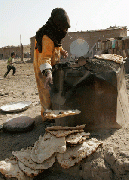Everyone knows the analogy of the beehive. When it is goaded, countless bees emerge, attacking the tormentor. Right now in Iraq, the formerly U.S.-backed al-Sahwa (Sons of Iraq) Sunni militia, ripe with broken promises from both the occupiers of their country and the Iraqi government that they would be given respect and jobs, have gone into attack mode.

|
|
A displaced woman bakes bread in Baghdad’s Abu Dsheer district April 22, 2009. About 40 Shi’a families live in mud houses after they were displaced by violence from different parts of Baghdad during the past years. REUTERS/Bassim Shati |
Not surprisingly, the Sahwa are fighting back against U.S. forces and those of the Iraqi government.
While not all of these attacks can be attributed to Sahwa forces, I believe it is safe to say the majority of them are. A brief overview of the last few days in Iraq is informative, as it shows many of these attacks, as well as some of the ongoing attacks by government forces against the Sahwa:
April 20: Suicide bomber wounds eight U.S. soldiers in Baquba, 40 miles northeast of Baghdad. Dubai-based satellite TV channel al-Arabiya reports that three of the U.S. soldiers were killed. The U.S. military does not confirm the deaths. Iraqi officials tell the media the bomber was wearing a police uniform. This method is becoming increasingly common now. Sahwa forces already have police and military uniforms, as they have been working as security personnel for months now. In another attack in the same city, a suicide bomber kills two U.S. soldiers, their Iraqi interpreter and two bystanders, although the U.S. military has not reported on the incident. Overall, 16 Iraqis killed, 11 wounded.
April 19: Gunmen kill an off-duty lieutenant-colonel policeman in his car in Baghdad. Mortar round wounds two civilians when it hits a power generator in the Zayouna district in east Baghdad. Police find the bodies of two Sunni Arab militiamen with bullet wounds in the head and chest in Hilla, 60 miles south of Baghdad. Gunmen kill two Sahwa members in separate incidents around Mussayib. Gunmen kill an Interior Ministry official in Nu’ariyah and another in Ur. The Interior Ministry is responsible for targeting the Sahwa leadership. In total, 14 Iraqis are killed, 28 wounded.
April 17: Mortar attacks across Shi’a-majority districts of Baghdad kill eight and wound 19.
April 16: A suicide bomber kills 16 Iraqi soldiers and wounds another 50 after infiltrating an army base in Habbaniyah, on the outskirts of Fallujah, and mingling with a queue of soldiers at a dining facility. The bomber is wearing a military uniform. A Sahwa leader is killed when a bomb planted on his car explodes in Baquba.
In addition to the aformentioned, there has been a dramatic increase in the number of bombings and roadside bombs across Iraq recently. On April 20, two young girls were killed in Fallujah when a sticky bomb targeting an army officer exploded outside their home as he left for work. The same day in Basra, a roadside bomb targeting a U.S. patrol detonated, but the military reported no casualties. April 19 saw a roadside bomb targeting a police patrol that wounded five people, including two policemen in the Zaafaraniya district of southeast Baghdad. That same day, another roadside bomb wounded four people in the Doura district of southern Baghdad, and the so-called Green Zone was shelled. On April 17, a roadside bomb wounded a policeman in Baquba, and three bombs were defused in Amara in southern Iraq.
There is a new kind of war on in Iraq — and it is spreading. Tit-for-tat killings between the Sahwa and government forces are increasing. Roadside bomb attacks and suicide strikes against U.S. forces are also increasing in recent days. Meanwhile, there is no sign of reconciliation between the Sahwa and the Iraqi government, and of course little if any of this is mentioned in most U.S. corporate media.
While the current trend still pales in comparison to previous levels of resistance in Iraq, if left unchecked, it will certainly continue to increase.
-IPS






Leave a Reply